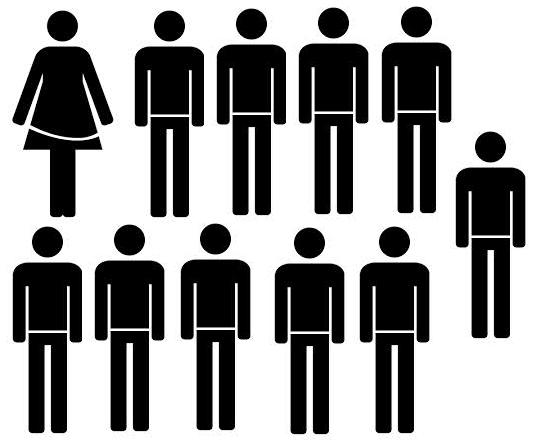Comparative Study on Sex Ratio at IITs vs Sex Ratio at US Colleges
 New Delhi: We all know about the skewed sex ratio at the IITs. For every eight to fourteen male students in premier engineering colleges in India, there is just one woman who takes admission in undergraduate engineering programs. Aspiring Minds – an initiative of IIT and MIT alumni – has made this low male to female ratio a subject of its 2013 study, which is titled ‘Women in Engineering: A Comparative Study of Barriers Across Nations’.
New Delhi: We all know about the skewed sex ratio at the IITs. For every eight to fourteen male students in premier engineering colleges in India, there is just one woman who takes admission in undergraduate engineering programs. Aspiring Minds – an initiative of IIT and MIT alumni – has made this low male to female ratio a subject of its 2013 study, which is titled ‘Women in Engineering: A Comparative Study of Barriers Across Nations’.
The number of female engineering students is much higher in the US where there is 1 to 1.4 women per four women at the MIT, Stanford University and the University of Berkeley.
Surprisingly, on the application stage though, the ratios are quite similar. Hence, for every 2.27 applicant, there is one woman applicant both at the IITs and the MIT.
The selection rate for male students is similar too – 7.2% at MIT and 6.4% at IIT.
However, the selection rate for female students shows a sharp contrast. While 15.5% female applicants made it to the MIT, only 1.9% female candidates could make it to the IITs.
At the IITs, male-to-female ratio range from 14:1 to 10:1. At NITs and other top state-run engineering colleges, male-to-female ratio is 8:1.
Why the Difference?
The US has taken several measurements to encourage more female students to pursue higher education in Science, Math, Engineering and Technology programmes. As a result, the number of women engineers has jumped up from less than 1% in 1970s to about 19% now.
The Indian government and the IITs also offers grace points in entrance exams to female students as well as takes less fees from women candidates too. The number of applicants too has increased from 29,291 in 2005 to about 1.5 lakh in 2012. However, women candidates who crack IIT JEE and reach the IITs are still low and remain between the disappointingly low brackets of 1.07% to 1.90%.
Study went on to find where the problem was. It surveyed 14,000 engineers and graduates from across India about their Class X percentage and the choice of their stream in Class XI. It was revealed that top 1% of the sample in the non-medical science stream (with engineering aspirations) was women.
Despite the availability of such high quality female candidates, gender ratio at the top engineering colleges in India is skewed. The study points out that the over-dependence on test scores lead is the reason why Indian institutes fail to pick up more female candidates.
MIT and the colleges realized that since the standardized test format is not much suitable for women. Hence, they designed a selection process which is much broader in nature. At MIT, 85% applicants with highest test scores are rejected in favour of students that demonstrate other strengths.
IITs on the other hand do not consider any candidate who is not in the Top 5% of the JEE Merit List.
The gender divide also became visible at the JEE coaching level. A 2010 survey on three most renowned engineering entrance coaching centers in six cities (including Delhi, Mumbai, Jaipur, Hyderabad and Tirupathi) revealed that only 17% to 24% candidates were females.
Most female students who made it to the IITs in the study had received proper JEE coaching and told about friends who could not crack JEE as they had no access to coaching classes.
Women also ranked lower in ‘self-perception of their ability’ than the men with same mathematical abilities. The silver lining is that the female engineering students in India fare much better than their counterparts in the US.
In the US, 30% of women who enroll in the engineering programs drop out later. Allegedly, women in the US faced disrespect and isolation. Only 18.5% receive degrees.
On the other hand, in India, the dropout rate is less than 5% for both male and female students. Female students in India had much more confidence than men and reported no such put-downs in college campus.
- Excited
- Fascinated
- Amused
- Bored
- Sad
- Angry
